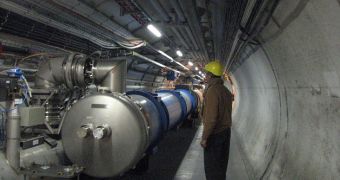Officials at CERN, the organization in charge of operating the Large Hadron Collider (LHC), announced recently that they had decided on a new start date for science programs at the world's largest and most powerful particle accelerator. The new date was set for Tuesday, March 30. At that time, officials say that the first collisions will take place at the recently-achieved energy level of 3.5 teraelectronvolts (TeV) per proton beam. These events will be the most energetic ever conducted on the planet, considering that the LHC only recently broke its own record for maximum output energy.
The new level was reached only last week, after the impressive particle accelerator was closed down for the holidays. When worked resumed, the army of scientists managing the 27-kilometer-long tunnels of the LHC managed to boost the power of each individual beam to the 3.5 TeV mark. The collider features two particle pathways, which accelerate proton beam in opposite directions to nearly the speed of light. The beams are then collided at a total energy level of 7 TeV, inside the three main particle detectors that adorn its rings. These special instruments are basically giant cameras, which are able to identify what type of elementary particles form as the protons collide and break apart.
But one of the main thing engineers need to look out for is how to make the beams stable. This is an absolute safety requirement before any collisions are attempted. The main goal of the accelerator is to eventually discover the Higgs boson, the massive elementary particle believed to be directly responsible for making energy acquire mass. “Symbolically, the start of the LHC research program is when we start systematically colliding beams for physics at the energy we have chosen for this year. That's what we're hoping for a week today,” told the BBC News the CERN director of communications, Dr James Gillies.
“With two beams at 3.5 TeV, we're on the verge of launching the LHC physics program. But we've still got a lot of work to do before collisions. Just lining the beams up is a challenge in itself. It's a bit like firing needles across the Atlantic and getting them to collide half way,” explains the European Organization for Nuclear Research (CERN) director for accelerators and technology, Steve Myers. Given that the collider has only been online since November 2009, the fact that it has already achieved this energy level is nothing short than a testimony of the skills and dedication of the thousands of experts working to bring it to life.

 14 DAY TRIAL //
14 DAY TRIAL //